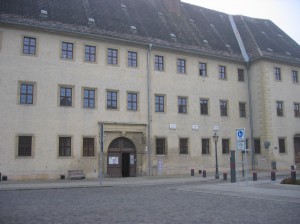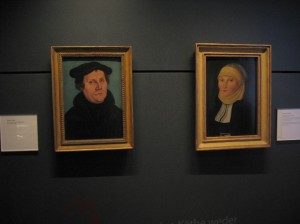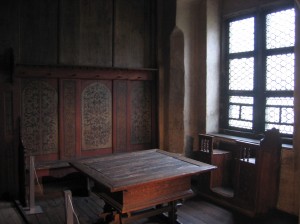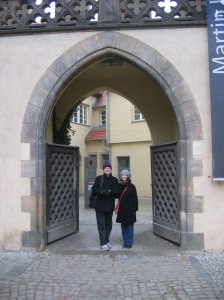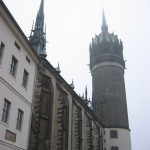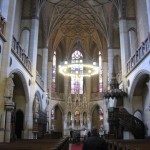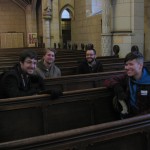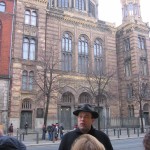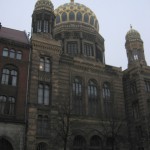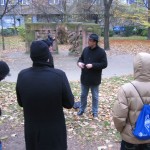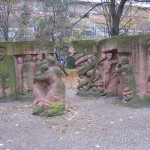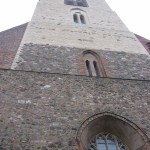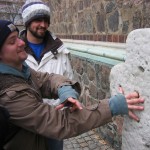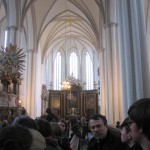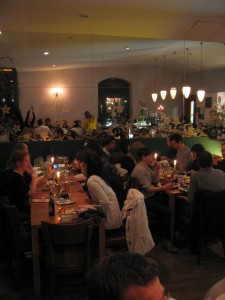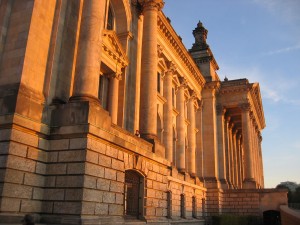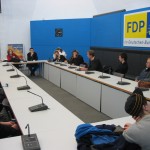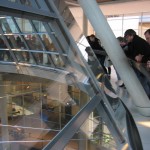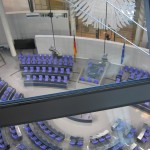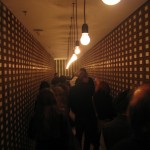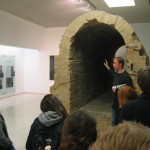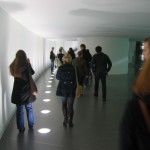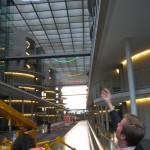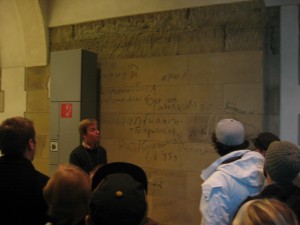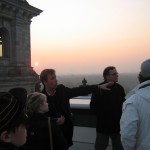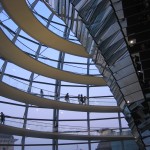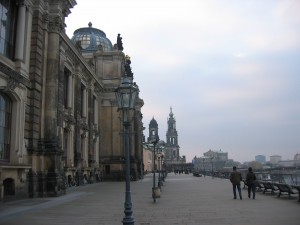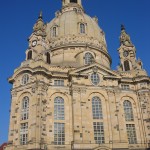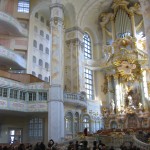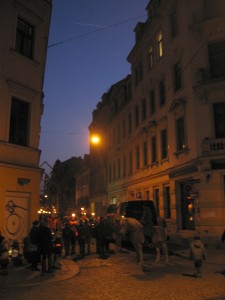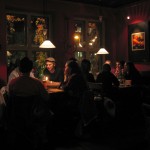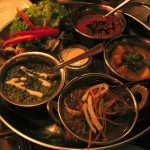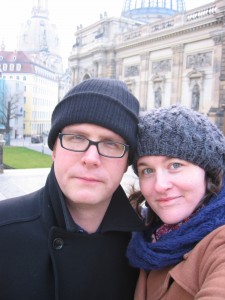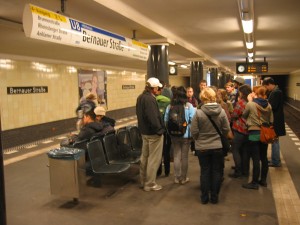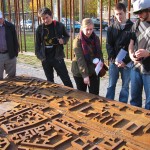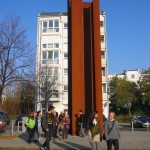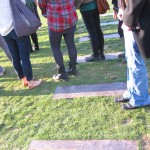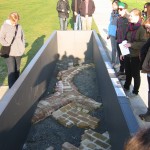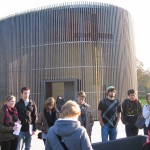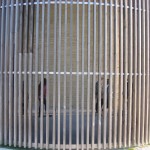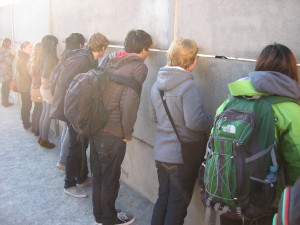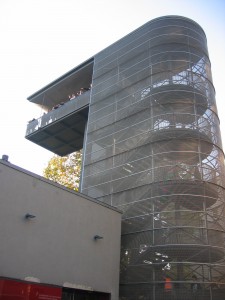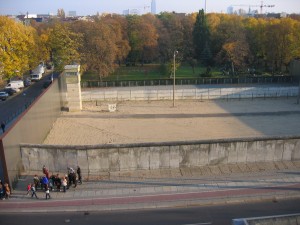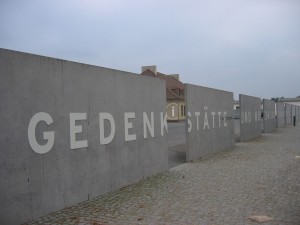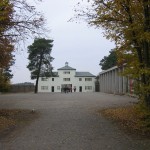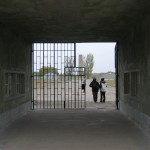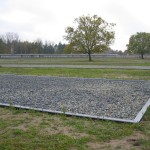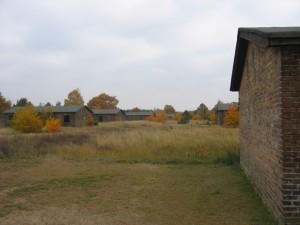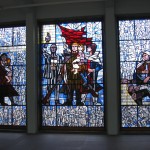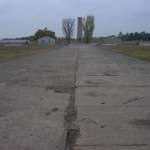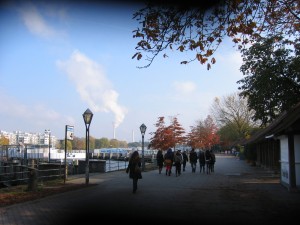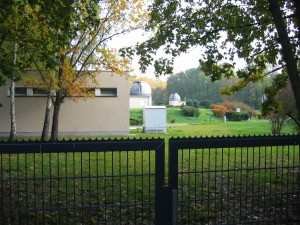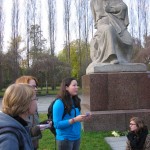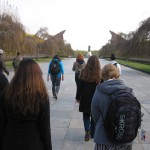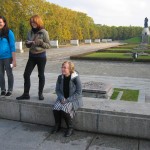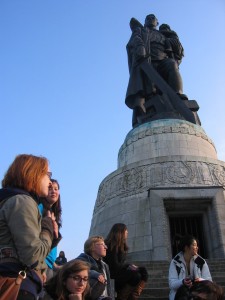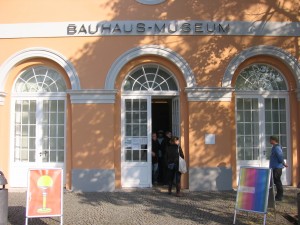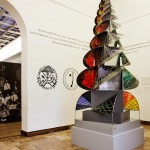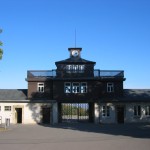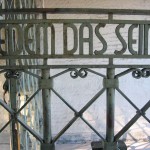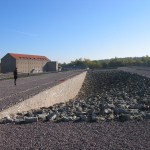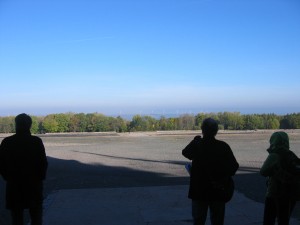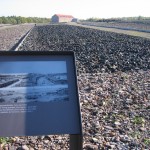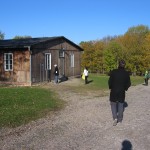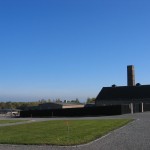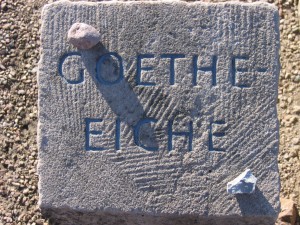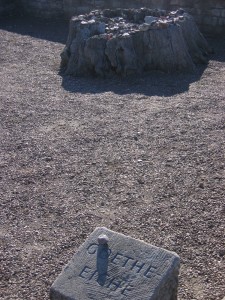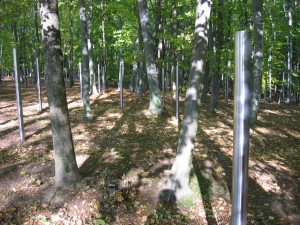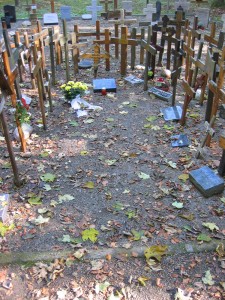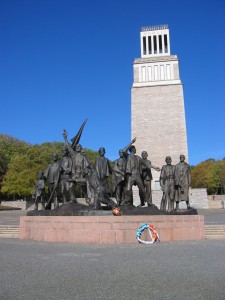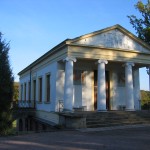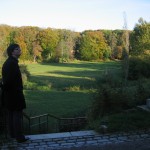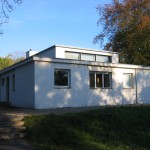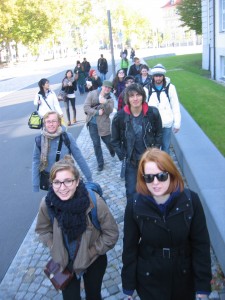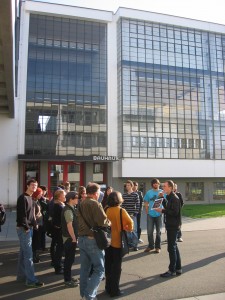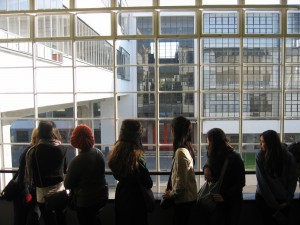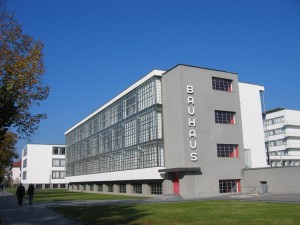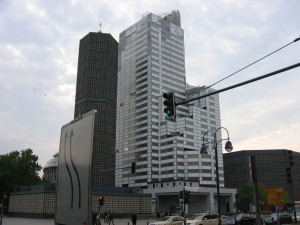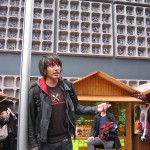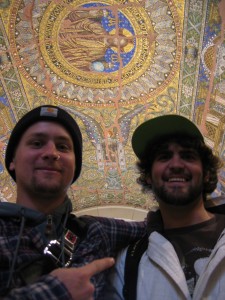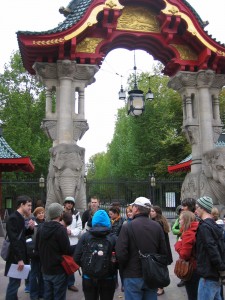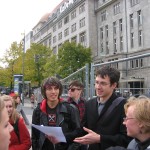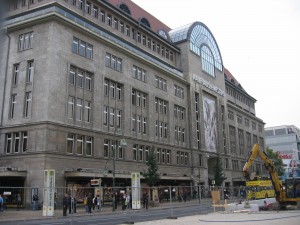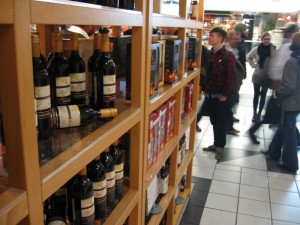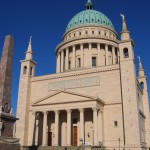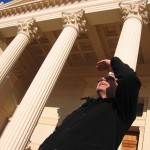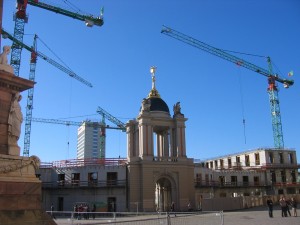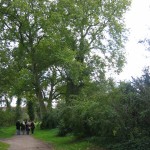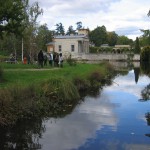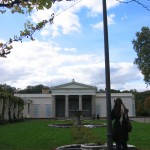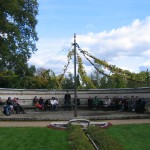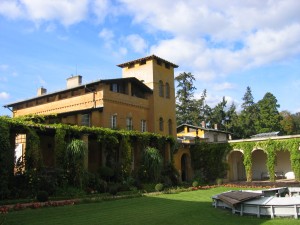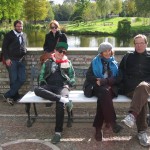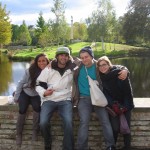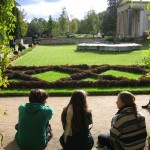A trip to Wittenberg
This Tuesday we took a day trip to the town of Wittenberg, about an hour away by train.
Wittenberg’s most famous resident was, of course, Martin Luther, who lived here in what was an Augustinian monastery and, after the Reformation, a school and his private residence.
The building is now an excellent museum on the history of the Reformation. One of its best features is the many paintings by Lucas Cranach, who was a close friend of Luther’s. Here are Cranach’s portraits of Luther and his wife Katharina, a former nun. Their marriage has become such a legend that it is reenacted every summer by the locals in Wittenberg!
A few of the rooms are wonderfully preserved, as well. Here is one of the rooms that Luther used as an everyday living space.
(John and Eleanor paused for a quick photo under the portal to Luther’s house.)
The other important site in Wittenberg is the Schlosskirche, where Luther famously nailed his 95 theses on the door in 1517. The church has burned down and been rebuilt since then, but it’s still a pretty amazing piece of history!
One thing that has really been brought home to us – especially in these last weeks, as we discuss contemporary German identity – is just how integral Christian, and in the north, especially Protestant, history is to an understanding of what many people believe it means to be German. This is where it all started, after all! And, as the history of the Reformation shows us, changing people’s assumptions can be difficult. As Germany moves into an age where multiculturalism is increasingly a feature of the social landscape, it will be interesting to see how they make sense of the shifts in religious identity, as well.
A tour of Mitte with Ulf Heinsohn
This Tuesday we took a walk through cold, foggy Mitte with Ulf Heinsohn, who helped us unpack some of the layers of meaning in the architecture around us. One of our first stops was the Neue Synagoge, or New Synagogue. Built in the 1860s, the building referred to both the history of Judaism and to its connections with Berlin: the style reflects one of the high points of Jewish culture (the Moorish architecture of the medieval period in Spain, where synagogues took on a look borrowed from Islamic architecture), but it uses a local traditional material (brick).
We also stopped at the Rosenstrasse memorial, which honors the wives of Jewish forced laborers who successfully protested their husbands’ deportation. The memorial was designed by the daughter of one of these couples.
At the Marienkirche, one of the oldest churches in Berlin, we learned how the architecture reflects the changes in the church community. The windowless front of the church was built that way in order to function as a fortress in case of invasion during the late medieval period. The cross in front of the church functioned in “trials by ordeal” — if the accused could fit their fingers in all five holes, they were considered innocent!
Our walk in the cold weather definitely earned us a delicious meal. Our group enjoyed a wonderful dinner together that night at Matzbach, one of our favorite German restaurants!
A visit to the Reichstag
Our activities this week included a tour of the Reichstag (the German parliament building).
Our guide was Ulli Finkenbusch, who works for the Free Democratic Party (FDP). After an introductory discussion about some important political issues facing Germany, we took a tour of the building, beginning with the mezzanine level.
On the lower level of the main parliament building, we viewed an artwork by Christian Bolstanski (left), consisting of metal boxes with the names of all the German Parliament members since 1919. We also saw the remains of the tunnel through which the arsonist who set fire to the Reichstag in 1993 is supposed to have entered building.
We then traversed the underground walkway connecting the Reichstag with the parliament meeting rooms and offices in the Paul-Löbe-Haus.
On our way back through the Reichstag, we glimpsed graffiti left by Soviet soldiers in 1945, which has been preserved as part of the integral history of the building.
Our final stop was on the roof, where Ulli pointed out several of the city sights that are visible from there, and we enjoyed a beautiful sunset!
Dresden: Florence on the Elbe
This Friday and Saturday our class took a trip to Dresden, a beautiful baroque city on the banks of the Elbe River.
The students explored several of the historic sites in the city, including the Frauenkirche. Once a famous ruin symbolizing the firebombing of Dresden, the church has been recently reconstructed.
Since the students were all responsible for seeing the sights on their own, we don’t have images of their explorations, but you can see Annie’s, Mariah’s, Melissa’s or Robert’s blogs for their own photos.
We also learned about an interesting German holiday in Dresden: St. Martin’s Day. Families walk together around the city holding lanterns. All of the cute little kids and their homemade lanterns were quite a sight!
On Friday night, we enjoyed a delicious group dinner at a local Indian restaurant!
… and Chance and I enjoyed Dresden, too!
A Tour of the Bernauer Strasse Wall Memorial with Libby, Roxana and Dominic
This week our students Libby, Roxana and Dominic took us on a tour of the Berlin Wall Memorial on Bernauer Strasse. We started the tour in the subway station, which during East German times had been a “ghost station” — because it lay in the East, it was a place that West German subways passed through but did not stop. Sometimes armed guards could be glimpsed in the darkened stations, but otherwise they were silent. Now they’ve been restored, and the U8 train stops at all the stations between Moritzplatz and Voltastrasse once more!
Emerging at street level, we entered the memorial site, which stretches for several blocks. The park encompasses what was formerly the ‘death strip’ – the space in between the two halves of the wall that divided East from West. Our tour guides directed us toward the many markers of structures that once existed on the site, including escape tunnels (right).
One of the most remarkable structures to have inhabited the death strip was an entire church, paradoxically named the Church of Reconciliation. It was demolished in the early 1980s by the East German government, but the foundations remain (left) and are now incorporated as relics in the park. A chapel has been built on the site to commemorate the many who died trying to escape over the wall.
Another portion of the park contains a reconstruction of the wall as it existed during East German times. This consists of a wall on the east side, then a large expanse of sand and barbed wire, and then finally another concrete wall on the west side. From the viewing tower that is part of the memorial museum (below), you can look down into this reconstructed portion.
Perhaps what is most amazing about this site is that it’s one of the only places in Berlin that you can tell there was ever a wall at all! The rest of the city has been so thoroughly sutured back together that you really have to hunt for the traces. This park preserves the memory of the terror that the wall once represented for Berlin’s citizens.
KZ Sachsenhausen: four layers of memory
Our visit to Buchenwald last weekend left us all with much to think about concerning the troublesome history of the Holocaust and the aftermath of WWII. This past Friday, we visited another concentration camp site, this time much nearer to Berlin. As opposed to Buchenwald, which is somewhat removed from the town of Weimar, Sachsenhausen is set essentially within the town of Oranienburg. The students were shocked to see how close the camp was to the surrounding houses: it reveals much about the attitude of many Germans toward the existence of these sites during the Nazi era.
The exhibitions and interpretive materials on the site (which is still in the process of being remodeled) seek to reveal four major eras in the camp’s existence. The first is the building and use of the camp by the Nazis, beginning in 1936. Though many Jews were imprisoned here, it was better known as a camp for political prisoners, especially Communists. It was also a prominent training site for the SS, as well as a “show” camp for Hitler and his officials. Though it wasn’t a death camp, tens of thousands of prisoners died here as a result of starvation, disease, abuse, and torture, as well as medical experiments.
After the war, the Soviets used Sachsenhausen as a “special camp” where they held various German prisoners to await trial. (Above: extra housing outside the camp walls which was used during this time.) Several thousand people died during this stage of the camp’s existence – mostly of starvation, disease and exposure. It’s difficult to know what to do with the memory of these deaths, as many of the prisoners were either Nazis themselves, or had been willing participants in the culture of the regime. Still, the evidence of human suffering here is also staggering.
After the Soviets abandoned the camp, the GDR government refurbished it (as they did Buchenwald) as a memorial site. Here at Sachsenhausen, this included a large memorial structure (where soldiers were regularly inducted into the army), as well as a museum that emphasized the suffering of the Communist prisoners held here by the Nazis. For East Germany, the identity of the Communists as victims of the fascist regime was a central part of the national narrative, so sites like these became points for the public expression of collective persecution at the hands of the Nazis – even if very few GDR citizens had actually been Communists prior to 1945. On the other hand, the memory of the Soviet camp was completely suppressed under the East Germans, so that families who had lost loved ones here during the post-war period were unable to speak about their own suffering until after 1989.
With the fall of the wall, the camp became a flashpoint for conflicting narratives and memories: how can both victims of the Nazis and Nazis or collaborators themselves be remembered and mourned on the same site? This is a question that haunts many spaces in Berlin, not only Sachsenhausen. The current design of the site attempts to deal with this through a “decentralized” approach, using the various structures to house extensive exhibitions of archival material. Still, we’re left wondering: how do we decide who has the right to be remembered, and how?
There are many more buildings on the site, but I couldn’t bring myself to photograph them. Sites of terrible suffering and unspeakable crimes, I think they are best left to be pondered in the abstract. If you’re interested, however, you can read more about the site here.
Treptower Park with Anna, Mariah and Janet
The student tour this week brought us to Treptower Park, home to …
… houseboats (one of three colonies in Berlin) …
An observatory built for a world’s expo in the park around the turn of the century, and later supposedly used by Einstein …
… and an absolutely massive Soviet World War II memorial and cemetery. Since the park lies in what was formerly East Berlin, it was a natural choice for the Soviets to honor 7,000 of their men who died here. The site is now under the official protection and care of the German government, thanks to a line in the treaty signed by the Soviets in 1989.
The main attraction is a 38-foot statue of a Soviet solder saving a child, posed over a broken swastika. Though it’s a bit over the top, one can’t help but think about the staggering number of men buried here. It’s another sobering facet of Berlin’s complex, and often tragic, history.
A trip to Weimar & Dessau
This weekend we traveled to the beautiful city of Weimar, home of Goethe, Schillar, Liszt, and the birthplace of the Bauhaus! Our first stop on Friday afternoon was the Bauhaus museum – a small but unique little space with treasures from the first years of the school’s existence. Unfortunately the Bauhaus school was forced to leave Weimar after the Nazi party gained power in the state of Thüringen in 1924.
This opened a difficult chapter in Weimar’s history, and on Saturday we visited the nearby site of Buchenwald concentration camp.
The most striking thing one finds on entering the camp is the view: the camp is set in the middle of the forest (Buche means “beech” and Wald means “woods”), on a hill that allows a view across the valley. It’s difficult to believe that such horrible things could transpire amidst such natural beauty.
The original barracks are no longer extant – most are now marked with dark loose stones, but one has been rebuilt in its original form. One of the few other buildings still standing on the grounds is the crematorium, which was strangely located adjacent to a little petting zoo built for the children of the SS.
The Goethe Eiche – Goethe’s Oak – was an oak tree left standing in the camp by the SS. The prisoners named it in remembrance of Goethe’s trips to this same forest. It was damaged in an Allied bombing in 1944 and subsequently chopped down.
Buchenwald was also used as a Soviet internment camp after the war. It’s thought that about 7,ooo people died during this time in the camp’s history, and they were buried in unmarked graves in the woods surrounding the site. Because Thüringen became part of East Germany, the deaths were not acknowledged during the Cold War. The fall of the Berlin Wall finally allowed the victims’ families to speak up and publicly remember their relatives.
The Soviets left another highly visible legacy: a huge memorial to the camp’s liberation, on a hill overlooking Weimar. Buchenwald’s many layers of tragic history gave us much to consider …
The class was free to spend the rest of the day exploring the town. Chance and I took a stroll through the park and admired the “Roman House,” the amazing landscape and the first Bauhaus demonstration house, the Haus am Horn.
Today we left Weimar and headed back to Berlin, with a stop in Dessau to visit the most famous site of the Bauhaus, their school building, designed by Walter Gropius and built in 1925-6. We got a fantastic tour from a very knowledgeable and enthusiastic guide, and I think our students might almost be convinced that Modernism isn’t all horrible … (those of us who study architecture are already sold).
We couldn’t have asked for a more lovely day to see this truly seminal piece of architecture. This week we dive into the study of the specter that haunts both the history of the Bauhaus and Buchenwald: the Nazis and their influence on Berlin and Germany.
Ku’damm, Zoo and KaDeWe with Robert, Dan and Niguel
Our students Robert, Dan and Niguel took us on a great tour of the Ku’Damm/Zoostation area of Berlin this Tuesday. We began just off the Ku’Damm at the Gedächtniskirche – the ruin of a church built by Kaiser Wilhelm II and bombed in 1943. The ruin has become one of the symbols of Berlin, but you can’t see it at the moment – it’s under that ugly white scaffolding you can see in the picture above. Surrounding the ruin are a chapel and belltower designed by the German modernist Egon Eiermann in the 1950s.
We headed into the ground floor of the ruin first. The ceiling still displays some beautiful Byzantine-style mosaics, duly appreciated by our class …
We then headed next door to the Eiermann-designed chapel. Though the newer buildings aren’t much to look at from the exterior (Berliners have nicknamed them the “lipstick and powder box”), the chapel is pretty stunning on the interior. We caught the organist practicing, which added to the atmosphere.
Our next stop was the zoo, where our guides not only acquainted us with the incredible diversity of its inhabitants – the most in the world! – but related the heartbreaking story of Knut, the baby polar bear born in the zoo in 2006. Knut was a media favorite (with good reason – he really was incredibly adorable!), but unfortunately he died earlier this year.
The mood picked back up as we moved to our last stop, the famous Kaufhaus des Westens, or KaDeWe. It’s the biggest department store in continental Europe, with a history that spans over 100 years.
The top floor of the store is known for its incredible selection of foods, both local and imported. And what should we find as we come up the escalators but a little taste of home – Columbia Crest, on sale. It seems we’re not the only Washington imports to Berlin!
A day in Potsdam
Our day trip to Potsdam featured more of our favorite 19th-century designer, Karl Friedrich Schinkel. (You probably think we’re just obsessed with him, but believe us – he truly was great!) We began at the St. Nikolaikirche near the city center. It was begun according to plans by Schinkel, but finished by his student Ludwig Persius.
Berlin isn’t the only city that is rebuilding past monuments – here you can see that Potsdam is also busily rebuilding its royal palace (across from the Nikolaikirche), as a home for the state parliament. Meanwhile, East German buildings on the other side of the square are slated for demolition and replacement.
A trek across Potsdam and through Sanssouci park brought us to another Schinkel site, this one built for a very elite audience – the crown prince.
Schinkel built a tiny summer palace (really the size of a summer home) for the prince, who was a prolific artist and designer himself. Together, they fashioned what the prince referred to as “Siam” – a utopian space filled with rich symbolism, much of which is now lost on those of us without the proper classical education!
Schinkel also designed a house for the court gardener, which later became a billiards room, tea lounge and general garden leisure space for the prince and his friends.
We took some leisure time ourselves – to contemplate the connection between human constructive activity and that of nature, as Schinkel intended – before heading off on our own walks through the rest of Sanssouci park. Next week: Berlin around the turn of the century!
tags
the author
I'm a doctoral student at CUNY Graduate Center. I'm thrilled to be teaching the CHID Berlin program with Prof. John Toews! You can contact me at naraelle [at] gmail.com, or find out more about me at www.naraelle.net.
Blogroll
- Annie Holden's blog
- Cassie Hoeprich's blog
- Dominic Barrera's blog
- Janet Williams's blog
- Mariah Alderete's blog
- Melissa Au's blog
- Robert Hampton's blog
- UW Students Study Abroad Our students Natalie and Cassie are contributing to the official IPE student blog this fall!



